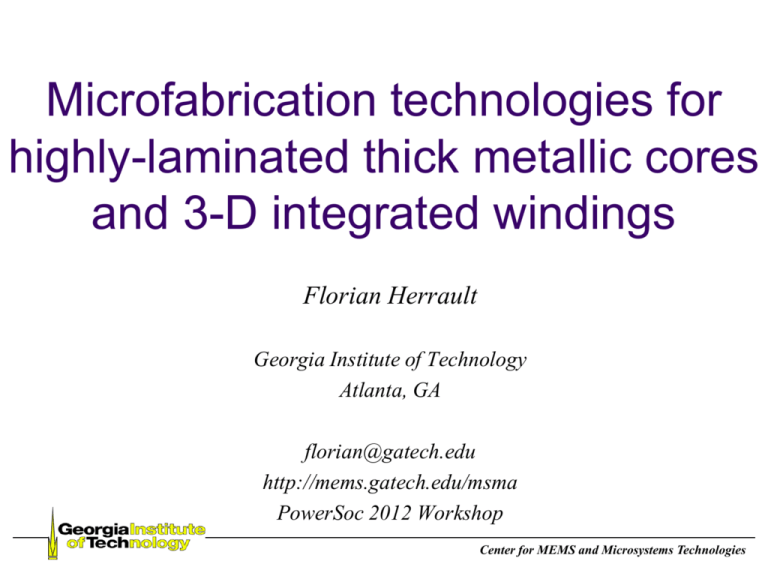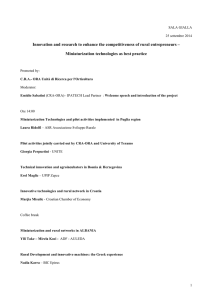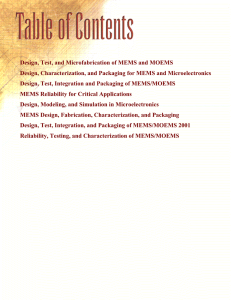300 layers - PowerSoC 2012
advertisement

Microfabrication technologies for highly-laminated thick metallic cores and 3-D integrated windings Florian Herrault Georgia Institute of Technology Atlanta, GA florian@gatech.edu http://mems.gatech.edu/msma PowerSoc 2012 Workshop Center for MEMS and Microsystems Technologies Acknowledgments Pr. Mark G. Allen (MSMA group - Georgia Tech) • Dr. Preston Galle • Dr. Jungkwun Kim • Minsoo Kim • Jooncheol Kim • Richard Shafer David Anderson (Texas Instruments) • Jizheng Qiu Pr. David Perreault (MIT) • David Otten Sponsors: Arpa-E, Texas Instruments 2 Center for MEMS and Microsystems Technologies Outline Metallic cores for high-frequency magnetics Highly-laminated magnetic metal cores • Concept • Fabrication and material selection • Core material characterization • Core loss measurements at High Fluxes and High Frequency Integrated Toroidal Inductors • Co-packaging of windings and cores • Microfabricated winding technology • Impedance measurements High-voltage Power Converter Experiments Conclusions 3 Center for MEMS and Microsystems Technologies Metal Core Inductors Advantages of electroplated metallic alloys High saturation (High operating flux density inductor miniaturization) Low coercivity (Low loss) Ability to electroplate in magnetic field to define easy/hard axis CMOS compatible Ability to electroplate thick cores (for large power handling) BUT Operation in the 1-20 MHz region requires a few m thick film lamination for conventional ferromagnetic metals (permalloy, CoNiFe, CoFe,…) 4 Center for MEMS and Microsystems Technologies Our Approach and Goals – Magnetic Cores Technology-driven development of thick highly-laminated metallic alloys Demonstrate low eddy current losses in metallic alloys at MHz frequencies Operate these cores at very high fluxes and high frequencies Demonstrate high power handling Integrate cores and microfabricated windings 5 Center for MEMS and Microsystems Technologies Previously-Reported Microfabricated Laminations Electrodeposition of magnetic material Multiple deposition steps of seed layer Multiple photolithography for 175molds and plating m insulators Overall core fabrication time is proportional to the number of layers Electrodeposition of magnetic material Sputter deposition of Magnetic material One deposition of seed layer High-aspect-ratio plating mold is required for large cross-sectional core Magnetic material 6 Alternate sputtering of magnetic materials and insulation layers Single vacuum step Process time Some patterning complexity Insulation material Center for MEMS and Microsystems Technologies Micron-Scale Laminations via Robotically-Assisted Multilayer Plating Robotic arm Wafer Rinse #1 Permalloy Conventional copper Rinse #2 Bright copper Filtration system Multilayer plating through mold Selective etching “Electroplating-based approaches for volumetric nanomanufacturing,” Tech. Dig. Technologies for Future Micro-Nano Manufacturing, Aug. 2011. 7 Center for MEMS and Microsystems Technologies Core Fabrication Technology a b Permalloymaterial Magnetic Copper PR SU-8 Ti Si Bd Ac Sequential electrdeposited Permalloy/Cu layers A. B. C. D. E. Ce Selective Cu etch after removing PR Df Applying SU-8 supports Full Cu etch Through-mold sequential electroplating of magnetic/sacrificial layers Mold removal, and partial etching of sacrificial material Formation of polymer supports Complete etching of sacrificial material Polymer infiltration (not shown) "Nanolaminated Permalloy Core for High-flux, High-frequency Ultracompact Power Conversion,” TPES, in press. 8 Center for MEMS and Microsystems Technologies Magnetic Material Selection Baseline material (Ni80Fe20) » » Bs ~ 0.8 T Hc ~ 0.7 Oe High saturation mat.(Fe10Co90) » » Bs ~ 1.9 T Hc ~ 1 Oe Low coercivity mat. (NiFeMo) » » Bs ~ 1 T Hc ~ 0.3 Oe Low coercivity and high saturation material (CoNiFe) » » Bs ~1.8-2 T Hc ~ 0.2-1 Oe 9 Center for MEMS and Microsystems Technologies Highly-laminated Microfabricated Cores 5 μm / 18 layers ~ 280 nm thick layers 10 mm 40-layer permalloy cores with 1-μm-thick laminations 40-layer CoNiFe core Cross-sectional view: Thick (2 μm) Cross-sectional view: 300-nm-thick permalloy laminations with thin permalloy laminations with 300-nm(300nm) copper interlayers tall interlayer gap (300 layers) 40-layer CoNiFe laminations with lamination thickness ~ 1 μm 10 300-layer CoNiFe laminations with lamination thickness < 0.3 μm Center for MEMS and Microsystems Technologies Wound Test Inductors Test Core Geometry » OD:10mm, ID:6~8mm Packaged with test bobbins » Characterization with high-power core loss measurement setup CoNiFe (1.8 T, < 1 Oe) vs. NiFe (0.8 T, 2 Oe) Wound inductors with inductances > 1 μH using 7-strand litz wire 11 Center for MEMS and Microsystems Technologies Manifestation of Eddy Currents in Inductors Suppressed eddy currents in metal cores manifested by constant inductance as a function of frequency No eddy current Inductance Depends on skin depth & lamination thickness Eddy currents are dominant Frequency 12 Center for MEMS and Microsystems Technologies In-Situ Measurements of Sacrificial Metal Etching Inductors packaged and wound before copper core etch Constant-voltage measurements performed in DI water Inductor under test DI Rinse Sacrificial layer etching time (%) Z analyzer connector In-situ core loss suppression experiment Inductor inductance as a function of frequency parameterized by sacrificial layer etching time 13 "Nanolaminated Permalloy Core for High-flux, High-frequency Ultracompact Power Conversion,” TPES, in press. Center for MEMS and Microsystems Technologies High-Frequency Inductance Measurements Inductors with permalloy cores Inductance (uH) ( H) ( H) inductance inductance 36-turn inductors Blue: 0 bias current Red: 0.5 A bias curent Green: 0.95 A bias current 1 1 0.5 10 10 frequency (MHz) Frequency (MHz) 10 0.5 2 100 100 100 frequency (MHz) 1000 22 1000 100 1 100 10 1 10 0.5 1 12 10 10 10frequency (MHz) 10 frequency (MHz) frequency (MHz) Frequency (MHz) 2 2 resistance () 300 core layers 0.3-0.5 nm thick layers 221 2 Inductance () () resistance resistance (uH) ( H) inductance Inductors with CoNiFe cores 18-turn inductors Solid lines: Inductor #1 Dotted lines: Inductor #2 2 100 100 100 100 80 1000 factorfactor quality quality Blue: 0 bias current 80 60 100 Red: 0.5 A bias 60 curent 40 10 bias current Green: 0.95 A 40 20 10 20 22 0 2 14 10 100 10 100 Center for MEMS and Microsystems Technologies frequency (MHz) frequency (MHz) 10 100 CoNiFe Cores – Bias Current Measurements 18 turn CoNiFe inductor 300 core layers 0.3-0.5 µm thick layers 10% L drop 20% L drop 30% L drop #1 0.35 0.55 0.75 #2 0.35 0.5 0.65 At 2 MHz 1 0.5 resistance () Resistance Isat (A) Batch 3, #1 Batch 3, #2 2 1.5 0 0 0.1 0.2 0.3 0.5 biascurrent current (A) (A) DC DC bias 0.4 0.5 0.6 0.7 0.8 0.9 1 1 1.5 Batch 3, #1 Batch 3, #2 1 0.5 0 factor Quality quality factor 2.5 inductance ( H) Inductance 0 0.1 0.2 0.3 0.5 bias current (A) DC DC bias current (A) 0.4 0.5 0.6 0.7 0.8 0.9 1 1 20 Batch 3, #1 Batch 3, #2 15 Q >20 at 1A bias current 10 5 0 0 0.1 0.2 0.5 DC bias current (A)(A) DC bias current 0.3 0.4 0.5 0.6 0.7 0.8 0.9 1 1 Impedance measurements under bias at Technologies 2 MHz Center for MEMS and DC Microsystems 15 HFHF Characterization Setup RF Amplifier input Capacitor bank Scope connectors (Vin) Inductor under Test Scope connectors (Vcap) Inductor Core Loss Test Board with 35nF capacitor boards Capacitor boards for frequency-dependent measurements 16 Center for MEMS and Microsystems Technologies HFHF Core Loss Measurements Dissipated power in the inductor as a function of frequency and parameterized by AC peak flux density "Nanolaminated Permalloy Core for High-flux, High-frequency Ultracompact Power Conversion,” TPES, in press. 17 Center for MEMS and Microsystems Technologies Analytical Separation of Eddy Current Losses Eddy current losses exhibit f^2 dependency Ptot Peddy Physt Hysteresis losses exhibit f dependency Ptot /f Ptot keddy * f ^2 khyst * f Ptot / f keddy * f khyst Ptot /f (or Pv_tot/f) Large eddy current losses slope = keddy Small eddy current losses Intercept = khyst No eddy currents (keddy = 0) Frequency Interpretation Analytical Extraction of Core Losses 18 Frequency Center for MEMS and Microsystems Technologies Post-Processed HFHF Core Loss Data "Nanolaminated Permalloy Core for High-flux, High-frequency Ultracompact Power Conversion,” TPES, in press. 19 Center for MEMS and Microsystems Technologies High Flux NiFe Core Loss Distribution Eddy and hysteresis losses extracted at 1 MHz as a function of flux At high fluxes, eddy losses have been suppressed and are negligible compared to hysteresis losses at 1 MHz "Nanolaminated Permalloy Core for High-flux, High-frequency Ultracompact Power Conversion,” TPES, in press. 20 Center for MEMS and Microsystems Technologies Core Lamination Performance Summary @ 1 MHz and 0.5 T Comparison of core loss at 1 MHz and high operating AC peak flux density 21 Center for MEMS and Microsystems Technologies Microfabricated Inductors with highly-laminated metallic cores Hybrid integration process Independently-fabricated magnetic cores are integrated halfway through the winding fabrication process 2 mm Monolithic process Co-fabrication of the windings and the cores through sequential micro-fabrication steps of electroplating and polymer insulation 2 mm “Integrated Toroidal Inductors with Nanolaminated Metallic Magnetic Cores,” Tech. Dig. PowerMEMS 2012 workshop. “Monolithically-fabricated laminated inductors with electrodeposited silver windings,” Tech. Dig. MEMS 2013. 22 Center for MEMS and Microsystems Technologies Hybrid Integration Concept Overview Copper coating SU-8 core Key winding fabrication concept “Microfabrication of air-core toroidal inductor with very high aspect ratio metal-encapsulated polymer vias,” Tech. Dig. PowerMEMS 2012 workshop. Independent fabrication of cores and windings Drop-in pre-insulated core • High-aspect-ratio copper-coated polymer vertical vias • Insulated cores dropped into the winding frame • Top winding fabricated core integration 23 Microfabrication of top copper windings Center for MEMS and Microsystems Technologies Microfabricated Inductors 50-turn microfabricated inductors (non-optimized geometry) New generation of integrated cores with CoNiFe layers Microfabricated conductor heights ~ 0.5 mm 2mm (a) Partially-fabricated windings on a glass substrate 2mm 2 mm (b) Batch of dropped-in cores Fully-fabricated inductor “Integrated Toroidal Inductors with Nanolaminated Metallic Magnetic Cores,” Tech. Dig. PowerMEMS 2012 workshop. 24 Center for MEMS and Microsystems Technologies Impedance Measurements of Microfabricated Inductors 50-turn microfabricated inductors with CoNiFe cores 100 layers – 300 nm thick layers “Integrated Toroidal Inductors with Nanolaminated Metallic Magnetic Cores,” Tech. Dig. PowerMEMS 2012 workshop. 25 Center for MEMS and Microsystems Technologies Power Converter Measurements Power converter circuit board and integrated inductor Testing board with wirebonded inductor ZVS buck converter “A technology overview of the PowerChip development program,” TPES, in press. 26 Center for MEMS and Microsystems Technologies 100 V Power Converter Measurements - 1.5 µH inductor with CoNiFe cores - P_out ~ 25-35 W - V_out = 35 V Power converter efficiency as a function of input voltage Power converter switching as a function of input voltage 27 Center for MEMS and Microsystems Technologies Summary Highly Laminated Metallic Cores: Technology-driven approach Microfabricated Inductors Cores and windings are co-packaged Demonstrated for large inductance inductors and small multi-phase topologies Demonstration in 100 V power converter Negligible eddy current losses High Saturation flux densities Low hysteresis losses Electroplating-based technology compatible with thick magnetic core fabrication and CMOS manufacturing Operation at 2-6 MHz and 35W output power Ongoing work on material reliability (corrosion, stress, packaging) and in-field material electroplating 28 Center for MEMS and Microsystems Technologies

